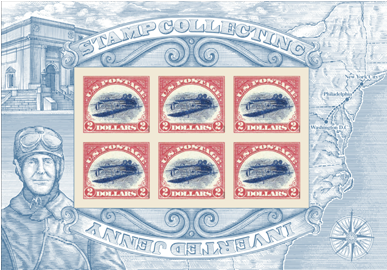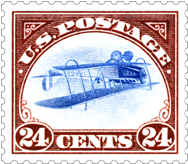
LOUISVILLE, KY — Nearly a century after it was first issued, America’s most famous stamp — the misprinted 24-cent Inverted Jenny — will be reprinted as a $2 stamp as part of the Stamp Collecting: Inverted Jenny souvenir stamp sheet.
The stamp was unveiled in Louisville during the American Philatelic Society’s AmeriStamp Expo at the Kentucky International Convention Center.
The sheet of stamps will be issued Sept. 22 to coincide with the Smithsonian’s National Postal Museum opening of the William H. Gross Stamp Gallery — the world’s largest stamp gallery.
This souvenir sheet features a new version of the most famous error in the history of U.S. stamps: the Inverted Jenny, a 1918 misprint that mistakenly showed a biplane flying upside down. Reprinted with a $2 denomination to make them easily distinguishable from the 24-cent originals, the Inverted Jennys on this sheet commemorate the many ways a single stamp can turn a moment in history upside down. The original engraved dies to produce the 1918 Inverted Jenny are being used in the design to produce the new stamps.

The 24-cent Curtiss Jenny invert error
In 1918, to celebrate the first Air Mail flight, the Post Office Department had the 24-cent Curtiss Jenny stamp produced.
Because the design required two colors, sheets were placed on the printing press twice — a process given to human error — as stamp collectors at the time well knew. One collector, William T. Robey, was on the lookout for stamps with printing errors on the morning of May 14, 1918, the first day of issuance for the stamp and the day before Air Mail service began.
To Robey’s amazement, a postal clerk handed him a 100-stamp sheet of the new Air Mail stamps mistakenly showing the biplane upside down within its frame. “The clerk reached down under the counter and brought forth a full sheet,” Robey recounted 20 years later, “and my heart stood still.”
Robey would soon learn that he had purchased the only sheet of misprinted Jenny stamps to fall into public hands. Within days, he sold the sheet to a stamp dealer, who immediately resold it to another collector. The sheet was broken up and the stamps were sold individually and in blocks of four.
For nearly a century, stamp collectors, referred to as philatelists, have chased the Inverted Jennys, accounting for nearly all 100 of them — even as the stamp became one of the country’s best known philatelic treasures. One of the remaining originals recently sold at auction for $625,000.
 Stamp design reflects preliminary artwork and is subject to change.
Stamp design reflects preliminary artwork and is subject to change.
2 Stamp Collecting: Inverted Jenny Stamp
This souvenir sheet includes six Inverted Jenny stamps, with a $2 denomination easily distinguishing them from the 24-cent 1918 originals. The six stamps appear in two rows of three at the center of the sheet. Around the block of six stamps, the selvage, or area outside of the stamps, features artwork by Steven Noble that evokes the engraving process while incorporating several philatelic elements.
The upper left corner shows the Smithsonian Institution’s National Postal Museum Building in Washington, DC. The lower left corner depicts aviation pioneer Reuben H. Fleet, based on a 1918 photograph now in the Library of Congress. Fleet was in charge of the first group of Air Mail pilots.
The right side of the souvenir sheet shows a map of the northeastern United States that focuses on the route of the first regularly scheduled Air Mail service in May 1918. A compass rose, a common element on maps and nautical charts, appears in the lower right corner.
A banner above the two rows of three Inverted Jenny stamps reads “STAMP COLLECTING.” Beneath it, upside down, is a similar banner reading “INVERTED JENNY.”
Stamp artist Steve Nobel of Petaluma, CA, worked under the direction of Antonio Alcalá of Alexandria, VA, to create the stamp and souvenir sheet.
National Postal Museum
Although this is the first time the Inverted Jenny has been reissued, a small Inverted Jenny stamp appeared as a design element on one of four 1993 stamps to mark the opening of the Smithsonian’s National Postal Museum.
Today, two Inverted Jennys soar among the National Postal Museum’s treasures. The Inverted Jenny is said to be the postage stamp most often requested for viewing by visitors.
William H. Gross Stamp Gallery
The issuance of this souvenir sheet coincides with both the 20th anniversary of the opening of the National Postal Museum in 1993 and the 2013 opening of the museum’s grand new William H. Gross Stamp Gallery. Intended to provide greater visibility and public access to the museum’s collection, the new 12,000-square-foot gallery will showcase numerous rarities, including a block of four Inverted Jenny stamps lent by the gallery’s benefactor, William H. Gross.
Named after its primary benefactor, the William H. Gross Stamp Gallery will be the world’s largest gallery dedicated to philately. It will provide an experience available nowhere else and offers something for everyone, from casual visitors to experienced collectors. As visitors move through six thematic areas, displays and interactive moments will reveal the stories that unfold from the museum’s collection. Distributed throughout the thematic areas will be hundreds of pullout frames containing more than 20,000 objects, providing ample opportunities to view noteworthy stamps that have never been on public display.
Customers may view the Inverted Jenny Souvenir Sheet, as well as many of this year’s other stamps on Facebook at facebook.com/USPSStamps, on Twitter@USPSstamps or on the website Beyond the Perf at beyondtheperf.com/2013-preview. Beyond the Perf is the Postal Service’s online site for information on upcoming stamp subjects, first-day-of-issue events and other philatelic news.
The Postal Service receives no tax dollars for operating expenses and relies on the sale of postage, products and services to fund its operations.
###
Please Note: For broadcast quality video and audio, photo stills and other media resources, visit the USPS Newsroom at http://about.usps.com/news/welcome.htm.
A self-supporting government enterprise, the U.S. Postal Service is the only delivery service that reaches every address in the nation — 151 million residences, businesses and Post Office™ Boxes. The Postal Service™ receives no tax dollars for operating expenses, and relies on the sale of postage, products and services to fund its operations. With 32,000 retail locations and the most frequently visited website in the federal government, usps.com®, the Postal Service has annual revenue of more than $65 billion and delivers nearly 40 percent of the world’s mail. If it were a private sector company, the U.S. Postal Service would rank 35th in the 2011 Fortune 500. In 2011, Oxford Strategic Consulting ranked the U.S. Postal Service number one in overall service performance of the posts in the top 20 wealthiest nations in the world. Black Enterprise and Hispanic Business magazines ranked the Postal Service as a leader in workforce diversity. The Postal Service has been named the Most Trusted Government Agency for six years and the sixth Most Trusted Business in the nation by the Ponemon Institute.
Follow the Postal Service on www.twitter.com/USPS and at www.facebook.com/USPS.

